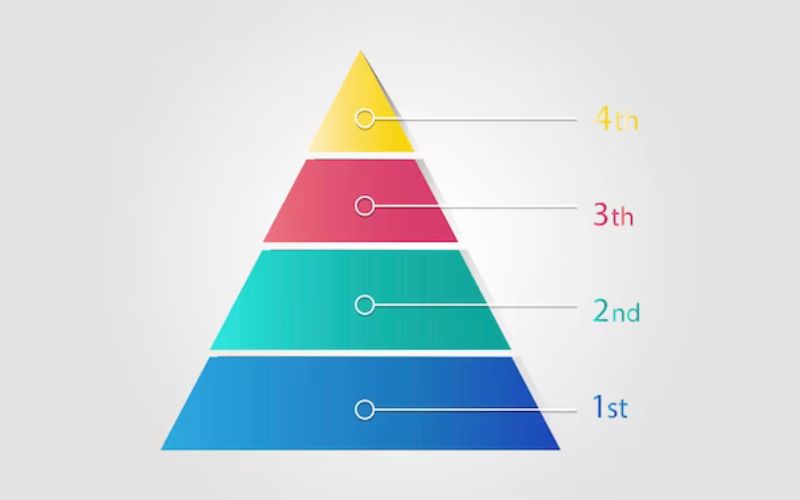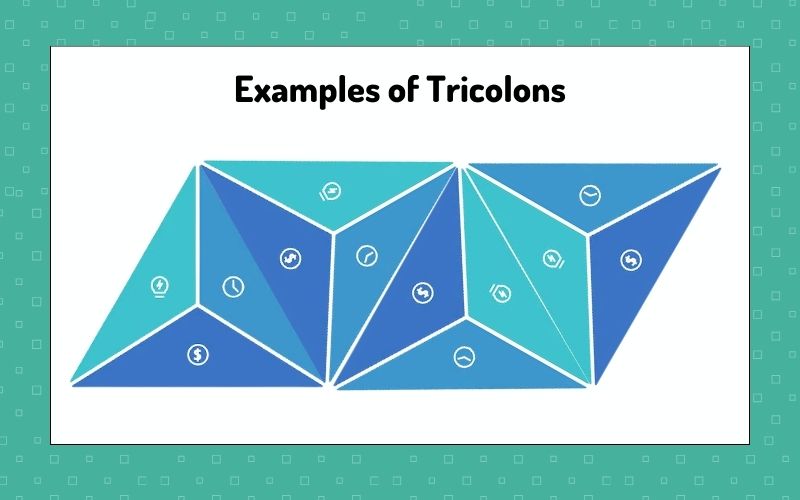Tricolons are a powerful rhetorical device that can be used to create a strong impact on the audience. It consists of three parallel clauses, phrases, or words that are presented in rapid succession without any interruption. The device has been used extensively in literature, speeches, and other forms of communication due to its ability to create a rhythmic and memorable effect on the listener or reader.
The tricolon’s effectiveness lies in its ability to emphasize and reinforce a particular idea or message by repeating it three times in a row. The device is often used to create a sense of urgency or importance, making it an essential tool for speakers and writers who want to leave a lasting impression on their audience.
Examples of Tricolons
Here are popular examples of tricolons:
- In the kitchen, I am a maestro of chaos, a conductor of culinary calamity, and a virtuoso of vegetable butchery.
- Life is unpredictable, like a rollercoaster without safety belts, a comedy without punchlines, and a GPS with a mind of its own.
- Love is like a puzzle – confusing, frustrating, and sometimes missing a piece or two.
- Trying to fix my sleep schedule is like herding cats, nailing jelly to a wall, and convincing a toddler that nap time is a great idea.
- Mondays are a trilogy of torment, tribulations, and a triumvirate of terrible timing.
- My closet is a labyrinth of lost socks, mismatched shoes, and forgotten fashion faux pas.
- Learning a new language is like deciphering hieroglyphics, cracking Morse code, and navigating a maze of linguistic labyrinths.
- The internet is a jungle of cat videos, conspiracy theories, and a never-ending abyss of clickbait.
- Coffee is my elixir of awakeness, my potion of productivity, and my wizardry in a mug.
- Procrastination is a dance with deadlines, a flirtation with failure, and a dalliance with disaster.
- Exercising regularly is like taming wild stallions, herding fitness felines, and convincing your inner couch potato to take a hike.
- Meeting deadlines is a juggling act of time management, a balancing act of priorities, and a tightrope walk of task completion.
- Social media is a carnival of selfies, a circus of status updates, and a parade of perpetual likes.
- Cooking without a recipe is a culinary adventure, a gastronomic gamble, and a recipe for potential disaster.
- My wardrobe consists of a rainbow of regret, a spectrum of fashion faux pas, and a kaleidoscope of questionable choices.
- Writing an article is a marathon of words, a sprint of sentences, and a jog through the jungle of grammar.
- Trying to find a parking spot is a quest for the holy grail, a treasure hunt in a concrete jungle, and a scavenger hunt of spaces.
- Singing in the shower is a symphony of soap, a melody of mist, and a chorus of cascading water.
- Parenting is a juggling act of diapers, a balancing act of baby bottles, and a tightrope walk of toddler tantrums.
- Navigating through rush hour traffic is a ballet of brake lights, a waltz of weaving, and a tango of tailbacks

Examples of Tricolons in Literature
Tricolons have been used extensively in literature. For instance, Shakespeare often employed tricolons in his works. In “Julius Caesar”, Mark Antony says, “Friends, Romans, Countrymen, lend me your ears.” In modern novels and poems, tricolons are used to add rhythm and emphasis. An example from J.K. Rowling’s “Harry Potter” series is the description of the Deathly Hallows as “the Elder Wand, the Resurrection Stone, and the Invisibility Cloak.”
Examples of Tricolons in Speeches
Tricolons are also prevalent in speeches, especially those of a political or motivational nature. One of the most famous examples is Julius Caesar’s “Veni, vidi, vici” (I came, I saw, I conquered). Another example is the motto of France, “Liberté, égalité, fraternité” (Liberty, Equality, Fraternity).
Analysis of Tricolons
The tricolon, a linguistic device that thrives on the power of three, has long been a favorite tool of writers aiming to add rhythm, emphasis, and a touch of flair to their prose. Let’s embark on a journey to unravel the mysteries of tricolons and understand why they hold such a captivating spell over our language.
- Rhythmic Resonance: Tricolons are akin to the beats of a drum or the steps of a waltz. The repetition of three elements creates a natural cadence, a rhythmic resonance that echoes in the reader’s mind. It’s the literary equivalent of a catchy tune that lingers long after it’s heard.
- Emphasis Amplified: The power of three is not just a whimsical notion; it’s deeply embedded in our cognitive processing. When we encounter a list of three items, our minds automatically give it extra weight and importance, tricolons, therefore, serve as amplifiers of emphasis, highlighting key ideas and making them memorable.
- Structural Symmetry: Like the three legs of a stable stool, tricolons provide a sense of structural symmetry to a sentence. The parallel structure they create fosters balance, making the sentence aesthetically pleasing and easier to comprehend. This structural harmony contributes to the overall coherence of the writing.
- Clever Contrast: Tricolons often find their charm in the art of contrast. By presenting three distinct ideas, writers can juxtapose elements for dramatic effect. This contrast can evoke emotions, create vivid imagery, and add layers of meaning to the narrative, captivating the reader’s attention.
- Mnemonic Marvels: The magic of threes extends to memory retention. Tricolons act as mnemonic devices, aiding recall by organizing information into a digestible and memorable format. This makes them valuable tools in persuasive writing, where the goal is not only to convey a message but to ensure it lingers in the reader’s mind.
- A Dash of Humor: Injecting humor into writing is an art, and tricolons can be a delightful brushstroke in this endeavor. The playful repetition of three elements allows for the setup and delivery of punchlines, creating a comedic rhythm that tickles the reader’s funny bone.
- Versatility in Expression: Tricolons are not confined to any specific genre or style; they are versatile and can be employed in various contexts. From the solemnity of speeches to the whimsy of creative writing, tricolons adapt to the tone and intent of the message, making them a universal tool in a writer’s arsenal.
Recent Posts
- Vapor Pressure Of Water Calculator
- Vapor Pressure Calculator
- Van Der Waals Equation
- Theoretical Yield Calculator
- Stoichiometry Calculator

